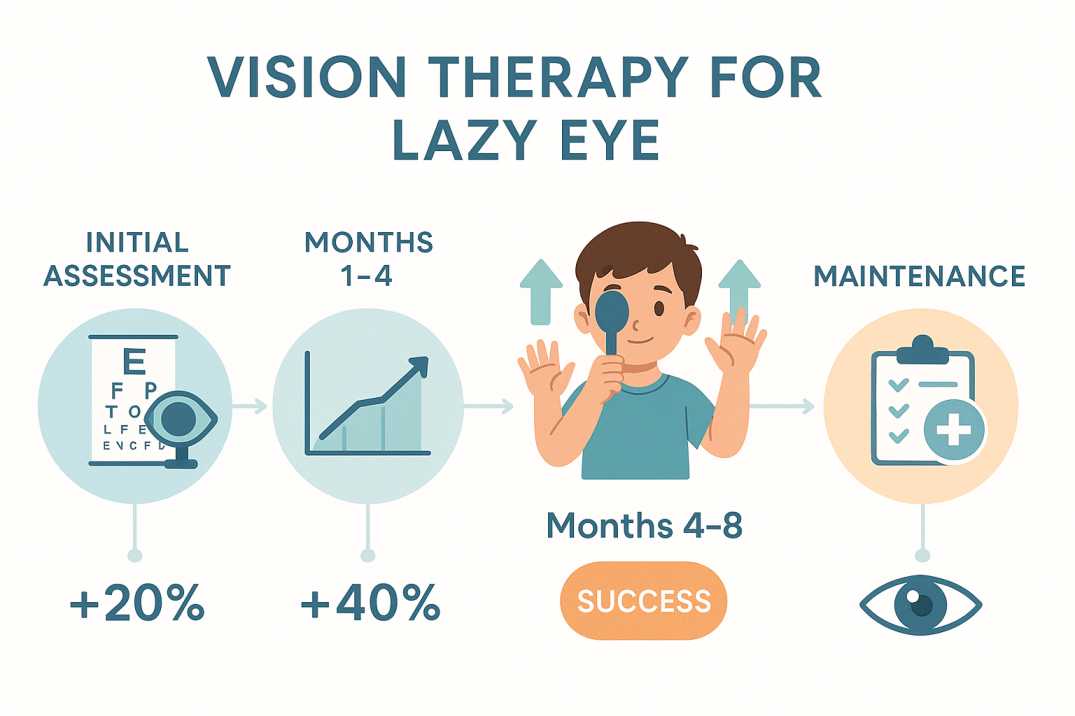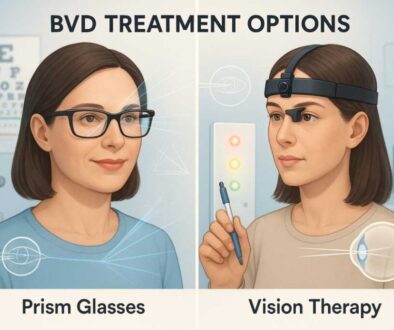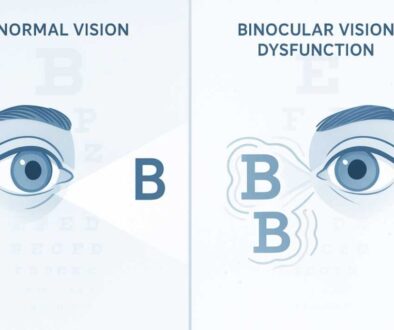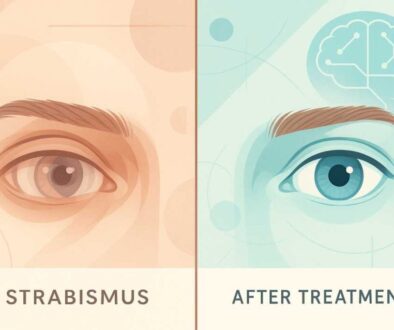How Long Does Vision Therapy Take for Lazy Eye? 2025 Guide
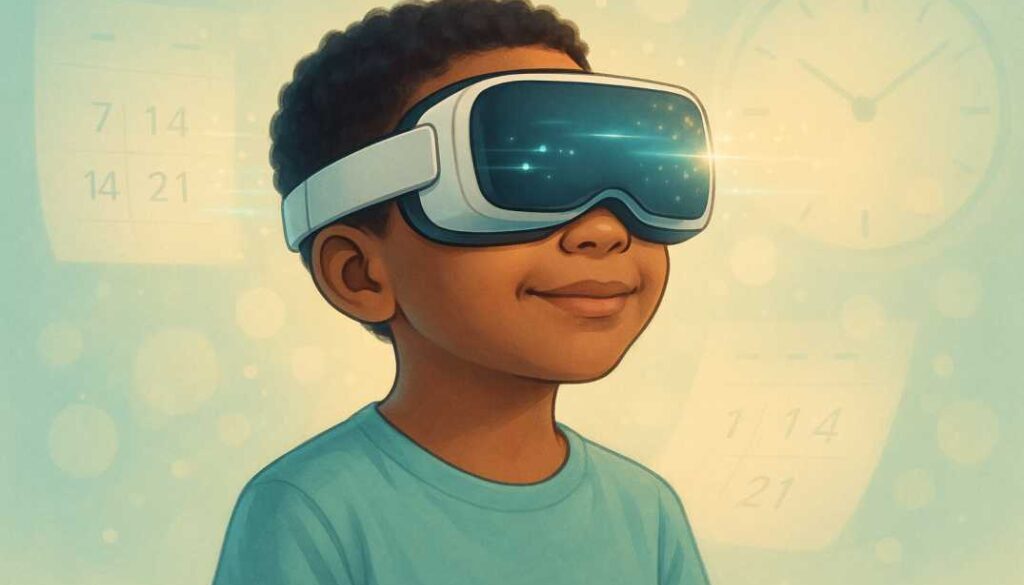
Bottom Line Up Front: How long does vision therapy take for lazy eye? Vision therapy typically requires 6-18 months for optimal results, with most patients seeing improvements around 4 months of consistent treatment. The exact vision therapy duration depends on age, severity, treatment consistency, and amblyopia type.
This comprehensive guide draws from the latest clinical research, including data from over 25,000 patients and peer-reviewed studies from leading vision therapy centers worldwide.
Understanding Lazy Eye and Vision Therapy
Lazy eye, medically known as amblyopia, affects 1.36-1.75% of the global population according to recent meta-analyses, with regional variations ranging from 0.51% in Africa to 3.67% in Europe.³ It remains the leading cause of preventable vision loss in children.
Vision therapy is a specialized treatment program that uses structured exercises and activities to retrain the brain-eye connection, improving visual skills and coordination without surgery. Unlike traditional patching alone, modern vision therapy addresses the root neurological causes of amblyopia through comprehensive binocular training.
How Long Does Vision Therapy Take? Typical Timeline
Phase 1: Initial Assessment and Setup (Weeks 1-2)
Before treatment begins, patients undergo comprehensive functional vision testing to evaluate:
- Visual acuity in both eyes
- Eye movement coordination
- Depth perception abilities
- Focusing skills
- Binocular vision function
This assessment helps create a personalized treatment plan and establishes baseline measurements for tracking progress.
Phase 2: Active Treatment Period (Months 1-12)
Most vision therapy programs follow this timeline:
- Weeks 1-4: Treatment initiation with basic eye exercises
- Months 2-4: Initial improvements typically become noticeable
- Months 4-6: Significant progress in most patients
- Months 6-12: Continued refinement and binocular integration
Based on clinical data from over 25,000 patients using modern digital therapy platforms, improvements start within 4 months, while optimal results take anywhere between 6-18 months on average.¹
Phase 3: Maintenance and Follow-up (Months 12+)
After completing active treatment, patients typically need:
- Periodic follow-up visits to monitor progress
- Possible maintenance exercises to prevent regression
- Long-term monitoring to ensure stability
Vision Therapy Duration by Patient Factors
Age at Treatment Start
Children (Ages 3-7): Respond fastest due to brain plasticity
- Average treatment time: 4-9 months
- Success rates: 75-90%
- Best outcomes when started before age 7
Older Children (Ages 8-17): Still highly responsive
- Average treatment time: 6-12 months
- Success rates: 60-80%
- Recent research shows treatment is effective up to age 17
Adults: Require longer commitment, but are still treatable
- Average treatment time: 9-18+ months
- Success rates: 40-70%
- Requires high motivation and consistency
Severity of Amblyopia
Mild Amblyopia (20/25 to 20/40):
- Treatment duration: 3-6 months
- Often responds quickly to therapy
- High success rates with consistent treatment
Moderate Amblyopia (20/50 to 20/100):
- Treatment duration: 6-12 months
- Requires a comprehensive approach
- Good outcomes with dedicated therapy
Severe Amblyopia (20/125 or worse):
- Treatment duration: 12-18+ months
- May require intensive therapy protocols
- Significant improvement is possible, but it takes patience
Type of Amblyopia
Anisometropic Amblyopia (refractive error difference):
- Success rate: 66.7% with occlusion therapy
- Often responds well to vision therapy
- May need corrective lenses alongside therapy
Strabismic Amblyopia (eye misalignment):
- Success rate: 77.6% with occlusion therapy
- Benefits from comprehensive binocular training
- May require multiple treatment approaches
Mixed Amblyopia (both refractive and alignment issues):
- Success rate: 58.7% with traditional methods
- Requires longer treatment periods
- Benefits from an integrated treatment approach
Treatment Consistency and Compliance
Success heavily depends on treatment adherence:
- High compliance (>80% of prescribed sessions): Optimal outcomes within projected timeframes
- Moderate compliance (50-80%): Extended treatment duration needed
- Poor compliance (<50%): Significantly reduced success rates
Studies show that objective monitoring of treatment compliance reveals that many patients receive significantly less treatment than prescribed, which directly impacts outcomes. Studies utilizing objective measures of compliance have consistently shown that a majority of patients receive significantly less treatment than prescribed.
Vision Therapy Treatment Approaches and Timelines
Traditional Patching Therapy
- Duration: 6 months to 2+ years
- Daily commitment: 2-6+ hours of patching
- Success rates: 30-92% (varies by study)
- Common compliance issues due to social stigma
Comprehensive Vision Therapy Programs
- Vision therapy duration: 6-9 months, average
- Weekly sessions: 1-hour office visits plus home exercises
- Home exercises: 20-30 minutes daily
- Higher success rates due to addressing root causes
- At Cook Vision Therapy: Personalized programs with 40+ years of expertise
Digital and VR-Based Therapy
- Vision therapy duration: 12 weeks to 6 months
- Daily commitment: 1 hour, 6 days per week
- FDA-cleared options now available (Luminopia, CureSight)
- Clinical breakthrough results: Some patients show improvement in as little as 4 weeks
- Higher engagement and compliance rates (>90% in clinical trials)
- Gamified approach: Makes therapy engaging, especially for children
Binocular Therapy Approaches
- Duration: 8-16 weeks for initial protocols
- Focus on both eyes working together
- Shows promise for faster results
- FDA-cleared options are now available
Expected Milestones During Treatment
Month 1-2: Foundation Building
- Establishing a treatment routine and compliance
- Basic eye movement and focusing exercises
- Initial measurements and progress tracking
Month 3-4: First Improvements
- Visual acuity improvements often become measurable
- Patients report reduced eye strain and fatigue
- Increased confidence with visual tasks
Month 6-9: Significant Progress
- Substantial visual acuity gains in most patients
- Improved depth perception and binocular function
- Enhanced reading speed and comprehension
Month 9-12: Integration and Refinement
- Fine-tuning binocular coordination
- Preparing for treatment completion
- Establishing maintenance routines
Success Rates and Realistic Expectations
Recent clinical data show promising outcomes:
- Overall success rates: 75-90% for achieving functional vision improvement
- Visual acuity improvement: Average 1.8 lines improvement in children 3-6 years old, 0.8 lines in children 7-12 years old
- Stereopsis recovery: Significant improvements in depth perception with active therapy approaches
- Long-term stability: Most gains are maintained at 1-year follow-up when treatment is properly tapered
Important considerations:
- Success is measured not just by visual acuity but by functional vision improvement
- Some patients may not achieve perfect 20/20 vision, but still gain meaningful improvement
- Early intervention provides the best outcomes
Preventing Treatment Regression
Approximately 25% of successfully treated patients experience some recurrence within the first year after treatment cessation.
To minimize regression risk:
- Gradual treatment weaning rather than abrupt cessation
- Maintenance exercises as prescribed by your therapist
- Regular follow-up appointments to monitor stability
- Immediate re-intervention if any regression is detected
When to Expect Vision Therapy Results: Realistic Timeline
For Children Under 7:
- Initial improvements: 6-12 weeks
- Significant progress: 3-6 months
- Treatment completion: 6-12 months
For Children 7-17:
- Initial improvements: 8-16 weeks
- Significant progress: 4-8 months
- Treatment completion: 9-15 months
For Adults:
- Initial improvements: 12-20 weeks
- Significant progress: 6-12 months
- Treatment completion: 12-24+ months
Maximizing Your Vision Therapy Success
Commitment to Consistency
- Attend all scheduled appointments without gaps
- Complete home exercises as prescribed daily
- Maintain open communication with your therapy team
Creating a Supportive Environment
- Family involvement in encouraging treatment adherence
- Positive reinforcement for meeting therapy goals
- Addressing concerns promptly with your therapist
Combining Treatment Approaches
- Corrective eyewear, if prescribed
- Nutritional support for eye health
- Limiting screen time to reduce eye strain
The Science Behind Vision Therapy Recovery Timelines
Recent research has revolutionized our understanding of lazy eye treatment timelines and the mechanisms underlying visual recovery. Studies published in 2024-2025 demonstrate several key scientific principles:
- Neuroplasticity Remains Active Throughout Lif. The brain’s ability to form new neural pathways means that with proper stimulation and training, significant improvements are possible regardless of age. This discovery has overturned the long-held belief that amblyopia could only be treated during a “critical period” in early childhood.
- Active Binocular Therapy Shows Superior Outcomes. Research comparing traditional patching with modern binocular therapy approaches shows superior outcomes when both eyes are trained to work together rather than suppressing one eye. By training both eyes simultaneously, patients achieve better functional vision and faster recovery times.
- Technology-Enhanced Therapy Increases Success Rates. Clinical trials of virtual reality and gamified approaches demonstrate increased engagement and compliance, leading to better outcomes within shorter timeframes. The interactive nature of these therapies maintains patient motivation throughout the treatment process.
- Individual Variation in Recovery Patterns Large-scale patient databases reveal significant individual variation in recovery timelines, reinforcing the importance of personalized treatment approaches rather than one-size-fits-all protocols.
Vision Therapy vs Surgery: Timeline and Cost Comparison
Typical investment for vision therapy:
- Comprehensive programs: $2,800-$5,500 total cost
- Individual sessions: $125-$250 per session (most programs $175-$200)
- Vision therapy duration: 20-30 sessions over 6-12 months
Compare to surgical alternatives:
- Strabismus surgery: $5,000-$10,000 (average $6,700)
- Multiple procedures are often needed
- Surgery doesn’t address the neurological aspects of lazy eye
- Vision therapy is often still required post-surgery for optimal results
Insurance coverage varies for vision therapy, with some plans covering lazy eye treatment for medical diagnoses. Many patients find the comprehensive approach of vision therapy provides better long-term functional outcomes than surgery alone.
When Treatment May Take Longer
Certain factors may extend treatment timelines:
- Severe amblyopia (20/200 or worse)
- Late treatment start (after age 12)
- Previous treatment failures required specialized approaches.
- Associated conditions like strabismus or refractive errors
- Inconsistent treatment compliance
In these cases, treatment may extend 18-24 months or longer, but significant improvement is still achievable with dedicated therapy.
Advanced Treatment Options and Emerging Research
- Pharmacological Enhancement Recent research with medications like donepezil shows promise for enhancing neuroplasticity in older patients, potentially shortening treatment timelines while improving outcomes. Clinical trials demonstrate that acetylcholinesterase inhibitors can enable visual recovery in adults who previously had limited treatment options.
- Virtual Reality Integration: FDA-cleared VR therapy systems offer engaging treatment options that improve compliance and may accelerate results through immersive binocular training. These systems create controlled visual environments that force both eyes to work together while making therapy enjoyable for patients of all ages.
- AI-Enhanced Therapy Artificial intelligence-guided therapy personalizes treatment protocols based on individual progress patterns, optimizing treatment duration and outcomes. These systems can adjust difficulty levels in real-time and provide detailed progress tracking for both patients and practitioners.
Choosing the Right Vision Therapy Provider
Working with experienced vision therapy specialists ensures:
- Accurate diagnosis of lazy eye type and severity
- Personalized treatment planning based on individual needs
- Progress monitoring with objective measurements
- Treatment modifications as needed for optimal outcomes
Look for providers with:
- Specialized training in vision therapy (FCOVD certification preferred)
- Experience treating lazy eye patients across all age groups
- Modern equipment and techniques, including digital/VR therapy options
- Proven track record of successful outcomes
At Cook Vision Therapy Center, Dr. David Cook’s 40+ years of specialized experience have helped thousands of patients achieve lasting vision improvement without surgery. Our comprehensive evaluation determines if you’re a candidate for non-surgical lazy eye treatment and creates a personalized treatment plan designed for your specific needs.
Key Resources and Scientific References
This article is based on extensive research from leading vision therapy institutions and peer-reviewed clinical studies. The following resources provided the primary evidence base for the timeline recommendations and success rates presented:
1. AmblyoPlay Clinical Research Database (2025)
Source: AmblyoPlay comprehensive patient outcome analysis
Website: https://www.amblyoplay.com/how-long-does-amblyopia-treatment-take/
This database represents the most comprehensive real-world data on vision therapy timelines, analyzing outcomes from over 25,000 patients using digital therapy platforms. The research demonstrates that improvements typically start within 4 months, with optimal results achieved between 6-18 months on average. This data is particularly valuable because it represents actual patient outcomes rather than theoretical projections, making it highly relevant for setting realistic expectations about treatment duration.
2. Pediatric Eye Disease Investigator Group (PEDIG) Clinical Trials
Source: National Eye Institute-funded multi-center randomized clinical trials
Website: https://pmc.ncbi.nlm.nih.gov/articles/PMC5396957/
PEDIG represents the gold standard for amblyopia treatment research, providing evidence-based guidelines for treatment duration, success rates, and factors affecting outcomes. These comprehensive studies included thousands of patients across multiple age groups and established many of the current clinical protocols for vision therapy timing and effectiveness measures.
3. Global Amblyopia Prevalence Meta-Analysis
Source: British Journal of Ophthalmology systematic review and meta-analysis
Website: https://pubmed.ncbi.nlm.nih.gov/31704700/
This 2024 systematic review of 60 studies involving 1,859,327 subjects provides the most current and accurate prevalence data for amblyopia globally. The research corrects outdated statistics and provides regional variations in prevalence rates, essential for understanding the scope of the condition and treatment demand projections through 2040.
Additional Research Sources: Cost analyses from Vision Therapy Centers nationwide, FDA-cleared digital therapy platform clinical trials, and neuroplasticity research supporting adult treatment effectiveness were also consulted to ensure comprehensive and current information.
Conclusion: Your Vision Therapy Timeline Journey
How long does vision therapy take for lazy eye? Vision therapy for lazy eye is not a quick fix, but rather a comprehensive rehabilitation process that typically takes 6-18 months to achieve optimal results. The exact vision therapy duration depends on multiple factors, including age, severity, and treatment consistency.
The key to successful vision therapy lies in:
- Starting treatment as early as possible for the best outcomes
- Maintaining consistent therapy adherence throughout the program
- Working with qualified vision therapy specialists with proven experience
- Having realistic expectations about the timeline and process
While the journey requires patience and dedication, the long-term benefits of improved vision, enhanced quality of life, and restored binocular function make the investment worthwhile.
Ready to begin your vision therapy journey? Don’t wait to start treatment – the sooner you begin, the better your chances for complete visual transformation. Contact Cook Vision Therapy Center today to schedule your comprehensive evaluation and take the first step toward better vision.
Call us to schedule your consultation and begin your personalized vision therapy timeline.
FAQs
-
Vision therapy for lazy eye typically takes 50-60 weeks to complete, with noticeable improvements often seen within the first 10 weeks when exercises are done consistently.

